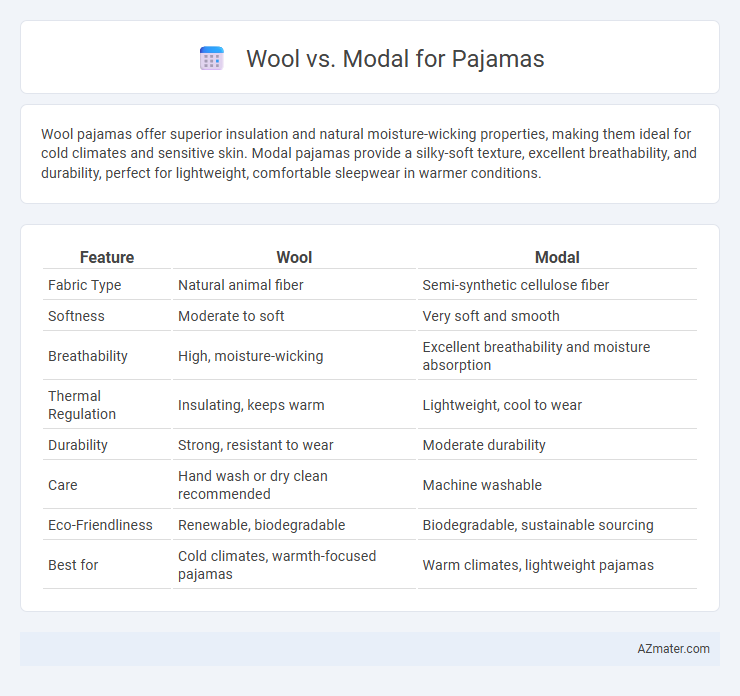Wool pajamas offer superior insulation and natural moisture-wicking properties, making them ideal for cold climates and sensitive skin. Modal pajamas provide a silky-soft texture, excellent breathability, and durability, perfect for lightweight, comfortable sleepwear in warmer conditions.
Table of Comparison
| Feature | Wool | Modal |
|---|---|---|
| Fabric Type | Natural animal fiber | Semi-synthetic cellulose fiber |
| Softness | Moderate to soft | Very soft and smooth |
| Breathability | High, moisture-wicking | Excellent breathability and moisture absorption |
| Thermal Regulation | Insulating, keeps warm | Lightweight, cool to wear |
| Durability | Strong, resistant to wear | Moderate durability |
| Care | Hand wash or dry clean recommended | Machine washable |
| Eco-Friendliness | Renewable, biodegradable | Biodegradable, sustainable sourcing |
| Best for | Cold climates, warmth-focused pajamas | Warm climates, lightweight pajamas |
Introduction: Wool vs Modal for Pajamas
Wool and modal are popular fabrics for pajamas, each offering distinct benefits for comfort and functionality. Wool provides natural insulation and moisture-wicking properties, making it ideal for cooler climates and maintaining warmth. Modal, derived from beech tree pulp, offers a soft, breathable, and lightweight alternative, perfect for those seeking smooth texture and excellent drape in sleepwear.
Overview of Wool Fabric
Wool fabric, derived from the fleece of sheep, offers excellent insulation and moisture-wicking properties, making it ideal for cozy pajamas. Its natural breathability and temperature regulation help maintain comfort in varying climates, while the durability of wool ensures long-lasting wear. Unlike synthetic fibers, wool is hypoallergenic and resistant to odor, enhancing overall sleep quality.
Overview of Modal Fabric
Modal fabric, derived from beech tree cellulose, offers exceptional softness and breathability, making it ideal for comfortable pajamas. Its moisture-wicking properties help keep the skin dry and cool during sleep, outperforming wool in temperature regulation. Modal's smooth texture and resistance to shrinking and fading enhance the durability and luxurious feel of sleepwear.
Comfort and Softness Comparison
Wool offers excellent insulation and moisture-wicking properties, making it ideal for regulating body temperature in pajamas, but it can sometimes feel coarse against sensitive skin. Modal fabric, made from beech tree pulp, is exceptionally soft and smooth, providing a silky feel that enhances overall comfort for sleepwear. When prioritizing comfort and softness, modal generally outperforms wool, especially for those with delicate skin or who prefer lightweight pajamas.
Breathability and Temperature Regulation
Wool excels in breathability and temperature regulation due to its natural crimped fibers that trap air, providing warmth while allowing moisture to escape, making it ideal for cooler climates. Modal, a semi-synthetic fabric made from beech tree pulp, offers excellent breathability but is less effective at retaining heat compared to wool, making it better suited for moderate temperatures. Pajamas crafted from wool maintain consistent body temperature by wicking moisture and insulating, whereas modal pajamas provide lightweight comfort with high moisture absorption but lower thermal regulation.
Moisture-Wicking Abilities
Wool excels in moisture-wicking abilities due to its natural lanolin content, which repels water while allowing sweat to evaporate, keeping the skin dry and comfortable during sleep. Modal, a semi-synthetic fabric made from beech tree pulp, offers excellent breathability and moisture absorption but does not dry as quickly as wool. Therefore, wool pajamas are often preferred for active or cooler climates where superior moisture management is essential.
Durability and Longevity
Wool pajamas offer exceptional durability due to their natural resilience and ability to retain shape over time, making them ideal for long-term use. Modal, while softer and more breathable, tends to have less resistance to pilling and wear, reducing its longevity compared to wool. Investing in wool pajamas ensures prolonged durability, especially in colder climates, while modal suits lighter, short-term comfort.
Care and Maintenance Requirements
Wool pajamas require careful hand washing or dry cleaning to prevent shrinking and maintain fiber integrity, with moisture-wicking properties that help regulate body temperature naturally. Modal pajamas, made from beech tree pulp, offer easier care with machine washable durability and quick drying times, making them low-maintenance while retaining softness and breathability. Both fabrics demand gentle detergents and avoidance of high heat drying to extend the lifespan of the garments and preserve their comfort qualities.
Sustainability and Eco-Friendliness
Wool pajamas offer natural insulation and biodegradability, making them a sustainable choice due to their renewable source and minimal chemical processing. Modal, derived from beech tree pulp, is eco-friendly as it uses sustainable forestry practices and closed-loop production that recycles water and solvents. Both fibers reduce environmental impact, but wool's biodegradability and renewable origin give it a slight edge in overall sustainability for sleepwear.
Conclusion: Choosing the Best Fabric for Pajamas
Wool offers excellent insulation and moisture-wicking properties, making it ideal for cold nights and those needing temperature regulation in pajama fabric. Modal provides softness, breathability, and a smooth texture, perfect for sensitive skin and warmer climates where comfort is key. Selecting between wool and modal depends on personal preference for warmth versus softness, ensuring pajamas deliver optimal comfort tailored to specific sleeping conditions.

Infographic: Wool vs Modal for Pajama
 azmater.com
azmater.com